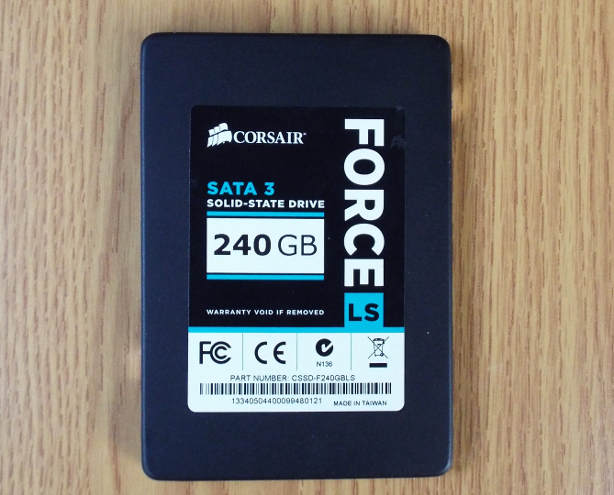FORCE SERIES LS 240GB COMPONENTS
The Force Series LS SSD is housed inside metal top and bottom covers, keeping the circuit board well-protected. The top cover’s bright label echoes the same black, white and turquoise color scheme as the retail box. The top cover is secured to the bottom cover with four tiny Phillips-head screws, two per long side.
The bottom of the case is black also, with two small silver foil anti-tampering stickers spanning the seam between the case halves. Once we slit the stickers to separate the case halves, the warranty is immediately compromised. The case halves can then be gently pried apart with a small flat-blade screwdriver or knife blade.
Now we can remove the four small Phillips-head screws that secure the printed circuit board to the bottom half of the case, and remove the PCB for further examination. The top side of the PCB sports eight 16GB NAND flash memory modules.
The bottom side contains the other 8 NAND modules, along with the Phison controller and a DRAM cache memory chip.
The 16GB NAND modules, of which there are a total of 16 (8 on the top side, 8 on the bottom side) are Toshiba 19nm architecture multi-level cell (MLC). Here we see a quartet of them:
The DRAM cache memory chip has a capacity of 512 MB.
Once we install the Force Series LS 240GB, initialize it and format it, after Corsair’s 16GB of over-provisioning we are left with 223.57 GB of usable capacity.
 The SSD Review The Worlds Dedicated SSD Education and Review Resource |
The SSD Review The Worlds Dedicated SSD Education and Review Resource | 


On page 3 of the review your yellow heading for “Crystal Disk Info Ver 3.9.3” appears to need correcting to keep in line with the version used in the test: 5.6.2.
It’s just amazing, the time we live in. SATA III just came out a couple of years back and some of us are disappointed with the 6Gbps speed, which constituted “the latest and the greatest” what feels like just yesterday.
I am very much part of that group. When I heard about the newly refreshed iMacs, I was disappointed that Thunderbolt 2 wasn’t part of the equation, as I am very much looking forward to a 4K monitor as soon as they’re less cost-prohibitive, but when I read down the press release and found out the new specs included a new PCIe SSD, I immediately sold off my now former souped-up Mac mini, and placed my order for one of those babies.